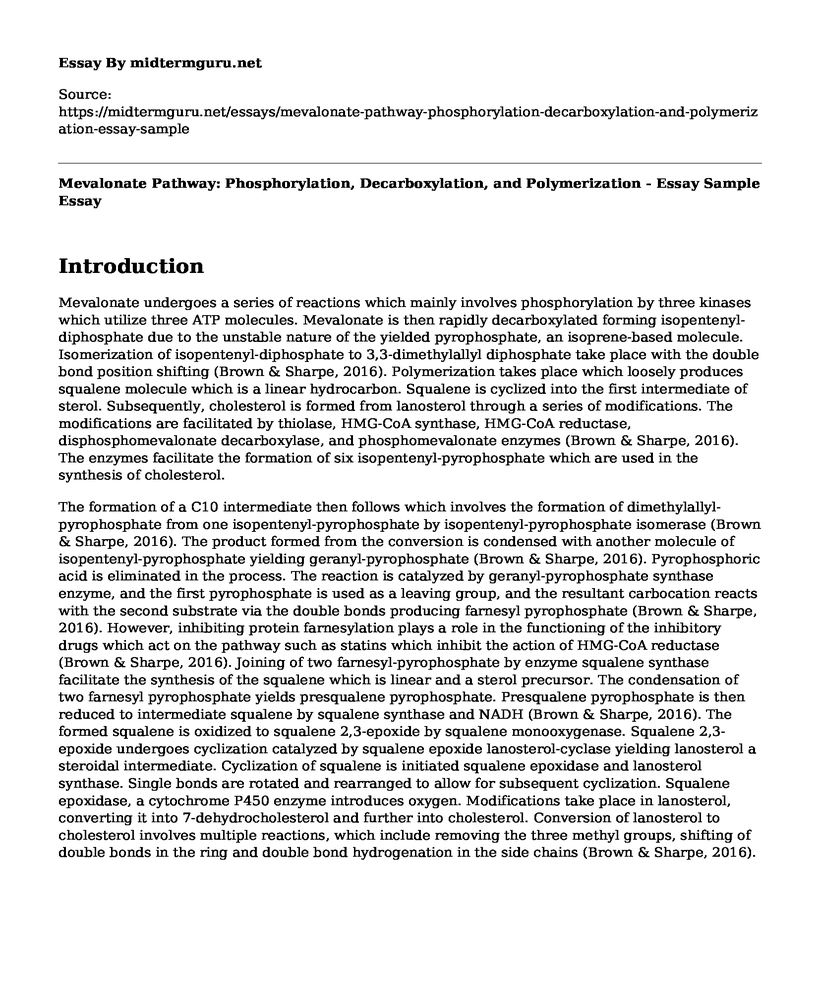Introduction
Mevalonate undergoes a series of reactions which mainly involves phosphorylation by three kinases which utilize three ATP molecules. Mevalonate is then rapidly decarboxylated forming isopentenyl-diphosphate due to the unstable nature of the yielded pyrophosphate, an isoprene-based molecule. Isomerization of isopentenyl-diphosphate to 3,3-dimethylallyl diphosphate take place with the double bond position shifting (Brown & Sharpe, 2016). Polymerization takes place which loosely produces squalene molecule which is a linear hydrocarbon. Squalene is cyclized into the first intermediate of sterol. Subsequently, cholesterol is formed from lanosterol through a series of modifications. The modifications are facilitated by thiolase, HMG-CoA synthase, HMG-CoA reductase, disphosphomevalonate decarboxylase, and phosphomevalonate enzymes (Brown & Sharpe, 2016). The enzymes facilitate the formation of six isopentenyl-pyrophosphate which are used in the synthesis of cholesterol.
The formation of a C10 intermediate then follows which involves the formation of dimethylallyl-pyrophosphate from one isopentenyl-pyrophosphate by isopentenyl-pyrophosphate isomerase (Brown & Sharpe, 2016). The product formed from the conversion is condensed with another molecule of isopentenyl-pyrophosphate yielding geranyl-pyrophosphate (Brown & Sharpe, 2016). Pyrophosphoric acid is eliminated in the process. The reaction is catalyzed by geranyl-pyrophosphate synthase enzyme, and the first pyrophosphate is used as a leaving group, and the resultant carbocation reacts with the second substrate via the double bonds producing farnesyl pyrophosphate (Brown & Sharpe, 2016). However, inhibiting protein farnesylation plays a role in the functioning of the inhibitory drugs which act on the pathway such as statins which inhibit the action of HMG-CoA reductase (Brown & Sharpe, 2016). Joining of two farnesyl-pyrophosphate by enzyme squalene synthase facilitate the synthesis of the squalene which is linear and a sterol precursor. The condensation of two farnesyl pyrophosphate yields presqualene pyrophosphate. Presqualene pyrophosphate is then reduced to intermediate squalene by squalene synthase and NADH (Brown & Sharpe, 2016). The formed squalene is oxidized to squalene 2,3-epoxide by squalene monooxygenase. Squalene 2,3-epoxide undergoes cyclization catalyzed by squalene epoxide lanosterol-cyclase yielding lanosterol a steroidal intermediate. Cyclization of squalene is initiated squalene epoxidase and lanosterol synthase. Single bonds are rotated and rearranged to allow for subsequent cyclization. Squalene epoxidase, a cytochrome P450 enzyme introduces oxygen. Modifications take place in lanosterol, converting it into 7-dehydrocholesterol and further into cholesterol. Conversion of lanosterol to cholesterol involves multiple reactions, which include removing the three methyl groups, shifting of double bonds in the ring and double bond hydrogenation in the side chains (Brown & Sharpe, 2016).
Regulation of the Synthesis of Cholesterol
HMG-CoA reductase (HMGR) is the regulatory enzyme during cholesterol synthesis. It has a feedback regulation initiated by cholesterol content in the bloodstream. Synthesis of cholesterol is dependent on the dietary composition of cholesterol. Limited cholesterol content in the bloodstream results into the initiation of the de novo synthesis of cholesterol by the liver (Brown & Sharpe, 2016). The enzymes that participate in the synthesis are membrane-bound and are released by the endoplasmic reticulum. Controlling the level of cholesterol is entirely dependent on the regulation of HMGR, which influence the biosynthesis level of cholesterol. Cholesterol serves as a feedback inhibitor of the preexisting HMG-CoA reductase, and therefore a rapid enzyme turn-over is induced.
Additionally, excess cholesterol in the body reduces mRNA content for HMG-CoA reductase due to reduced gene expression. Regulation of the HMGR is also attained by covalent modification of the enzyme effected through phosphorylation and dephosphorylation (Alphonse & Jones, 2016). The active form is dephosphorylated while the inactive form is phosphorylated. Phosphorylation is effected by AMP-regulated protein kinase (AMPRK). AMPRK is activated through phosphorylation by kinase kinase, and therefore it is in an activated form.
Cholesterol biosynthesis is affected by the activity of glucagon and epinephrine. They increase the action of phosphoprotein phosphatase inhibitor-1 (PPI-1) (Alphonse & Jones, 2016). Insulin increases the synthesis of cholesterol by stimulating phosphates removal and resultantly activating the activity of HMG-CoA reductase.
Conclusion
Cholesterol is presented as a crucial component of the body and key to various physiological functions of the body. It is an important component of the cell membrane and also circulates in the bloodstream. However, the molecule is insoluble in blood and therefore interacts with lipoprotein complexes for transport in the bloodstream. Low-density lipoprotein transport cholesterol from the liver to the body parts, and it contributes to the large component of cholesterol in the blood. High-density lipoprotein transports excess and unused cholesterol in the bloodstream back to the liver they are used as precursors for bile acids. The amount of cholesterol is balanced through dietary intake and de novo synthesis, which take place in the liver. The process of cholesterol synthesis takes pla...
Cite this page
Mevalonate Pathway: Phosphorylation, Decarboxylation, and Polymerization - Essay Sample. (2023, Jan 27). Retrieved from https://midtermguru.com/essays/mevalonate-pathway-phosphorylation-decarboxylation-and-polymerization-essay-sample
If you are the original author of this essay and no longer wish to have it published on the midtermguru.com website, please click below to request its removal:
- Essay on Innovation Architecture of Organization and Management of Innovation
- Essay on Chemical Contamination of Food Substances
- Research Paper on Information Technology in Support of Robots
- Paper Example on Physical Anthropology
- Creativity vs Innovation: Analyzing the Differences - Essay Sample
- Cultural Practices of Ethnic Groups: Global Differences & Civilization - Research Paper
- Article Analysis Essay on Evolution of Minerals







